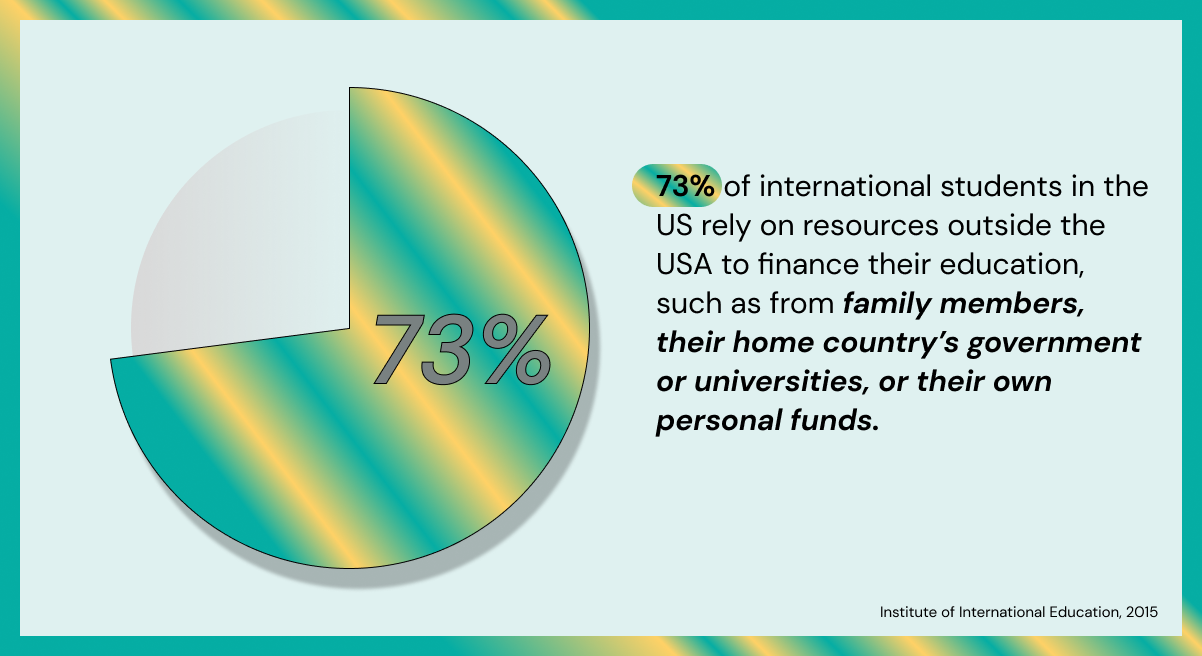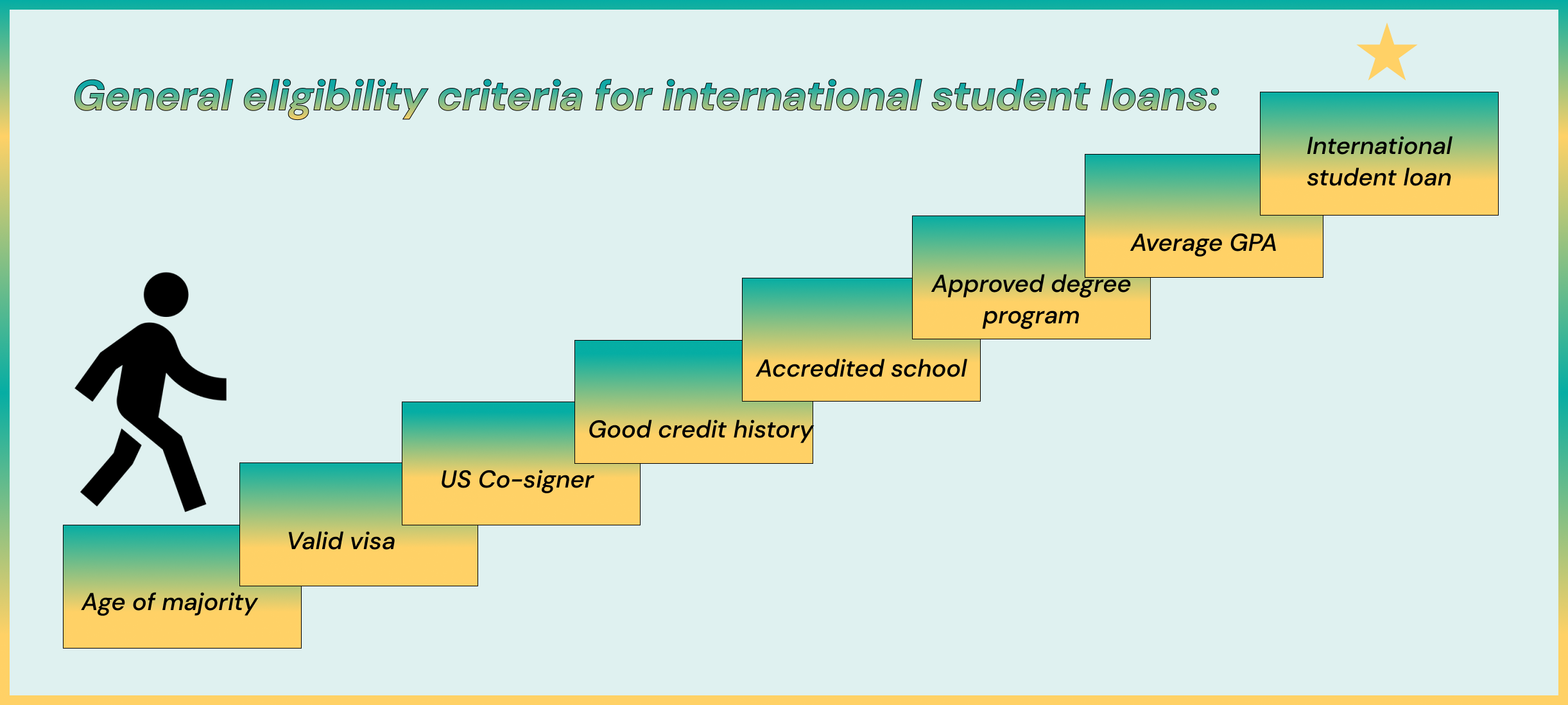How does an international student pay for education in the United States? This is a complex and multilayered question with no single answer. Each situation is unique. However, most often, students use their family funds or apply for specialized scholarships and grants. There is also another possibility, but it entails significant financial obligations: applying for an international student loan.
This solution to the financing problem is less common than other ones, but it is also an effective way to pay for studying abroad. If this topic resonates with you and you would like to learn more about international student loans, keep reading. We have prepared a lot of interesting information for you.
What Is a Loan for International Student and How Does It Work?
Let’s start with the basics. International students do not qualify for federal student loans from the US government, which have more lenient conditions. Instead, they can only apply for private loans from private lenders.
An international student loan from a private lender is a loan to a non-US resident from an authorized financial institution that provides funds to cover educational expenses.
This means the borrowed amount should cover not only the cost of education but also related expenses, such as fees, books, school supplies, transportation, insurance, and accommodation.
Organizations authorized to issue loans to foreign learners include banks, credit unions, and online lenders. The borrower must repay all the granted funds with interest within a clearly defined period. In most cases, an international student applies for the amount of money needed to cover expenses for the next academic year. However, it is also possible to receive an amount that covers the entire period of study at an American college. After the lender approves the foreign enrolled loan, it must verify the requested amount with the educational institution. When all the formalities are resolved, the lending institution sends the funds directly to the college for international students where you are enrolled. Any remaining amount will be sent to your account.
The repayment terms of private student loans for international students may differ dramatically between lenders. However, usually, students are given a six-month grace period after graduation to repay the funds. Only then will they start repaying the loan amount with interest.
Non-US Citizens Eligible for Federal Financial Aid
As we mentioned above, international students mostly do not qualify for financial aid from the US government. However, as with most rules, there are some exceptions. With all of the above in mind, we have some good news for you. Even if you are not a US citizen, there is a possibility that you may be eligible for federal funding assistance.
HANDPICKED RELATED CONTENT:Financial Aid for International Students in USA: Where to Start? |
According to the US Department of Education, It is fully accessible to you if you are:
- US nationals, including those who are from American Samoa or the Swains Island
- Permanent residents of the United States who hold a valid “green card”
- Persons who have a valid I-94 form from the US Citizenship and Immigration Services (USCIS)
- Valid T1-visa holders and their children
- Anyone considered a “battered immigrant-qualified alien”
Even if you don’t fall into any of these categories, you should consider taking out a loan as the last option to pay for your education without your parents’ help.
What You Should Definitely Know About an International Student Loan
A student loan is a serious commitment. Therefore, it is natural that it is associated with the fulfillment of a number of strict requirements. As an applicant, you must clearly understand what exactly is necessary to receive financial aid for study. It is equally important to understand your rights and obligations regarding loan repayment.
The most important things you should know about loans for international students include the following:
- Valid visa. Lenders require international students to have a valid student visa (F-1 or M-1) to provide them with a loan.
- Enrollment in an eligible educational institution. Young adults who want to obtain a student loan must be enrolled or admitted to a US college or university. This educational institution must have a current, generally accepted level of accreditation.
- Co-signer from the United States. The lion’s share of lenders require a co-signer to obtain private student loans for international students. This person must be a US citizen or permanent resident. They give a guarantee to the lending institution that the loan will be repaid in one way or another.
- Credit check. One of the loan requirements is assessing the credit histories of an applicant and a co-signer. Therefore, both of them must have a good credit rating.
- Financial documentation. The lending organizations have the right to require the borrower’s bank or income statements. They might need these documents to check their ability to repay US student loans for international students.
- Satisfactory academic performance. Lenders often require borrowers to have a satisfactory academic record. That is, the student must have a sufficient number of credits per semester and a minimum satisfactory grade point average.
- Loan limits. Being responsible and not exceeding the lender’s credit limits is extremely important. This can result in highly unpleasant consequences for the borrower.
- Interest rates and fees. Once the student loan for international student is approved, a careful reading of the agreement is a must. A student should pay particular attention to the type of interest rate (fixed or floating) and how it is calculated. It is critical for the borrower to understand the interest rates and fees associated with the loan.
- Repayment terms. Students need to study the terms of the loan carefully. They should clearly understand the terms and conditions of the loan, the repayment schedule, the grace period, and the interest calculation procedure.
- Loan application. When filling out a loan application, the applicant should be extremely careful and attentive. Errors in personal data can cost approval for a loan.
How to Compare International Student Loans
The most important thing to remember is that various lenders impose different terms and conditions on their loans. Therefore, your task as a borrower is to carefully study the offers from different providers and choose the international student loan options that suit you best.
Financial deals are complex and require the knowledge of specific terminologies. If you have difficulty understanding them, ask the lender or your college’s financial aid office for clarification.
The basic criteria for comparing offers from different lending institutions are as follows:
- Interest rate. It can be variable or fixed. A variable or floating rate changes over time. A fixed rate remains unchanged for the entire term of the financial liability. It should be noted that variable rates can sometimes be lower at first, but they will change from year to year and not necessarily in the borrower’s favor.
- Repayment requirements. Under the terms of the abroad loan, lenders can require the student to repay interest or full payment monthly starting from the moment they receive the money. However, some offers allow applicants to defer all payments until six months after graduation.
- Repayment term. Lenders may allow students to choose the repayment term length. Borrowers should familiarize themselves with detailed information about the monthly costs for student loan options for international students. By comparing offers from different lenders, they will be able to understand which one is more advantageous for them, as well as take into account the total cost over the entire loan term.
- Hardship allowances. The applicant should have full information about the possibility of suspending payments due to unforeseen circumstances or temporary financial difficulties.
- Discounts. Some lenders offer an interest rate discount for borrowers who sign up for automatic payments or make a certain number of consecutive payments on time. This is worth keeping in mind.
- Co-signer exemption. Not all lenders require a co-signer to issue a student loan for international learners. This is an important nuance for those who do not have relatives or friends who would be willing to support their loan application.
An International Student Loan with a Co-Signer
As mentioned above, a lender often insists on a co-signer to approve a loan to an applicant. This is a typical requirement, and there are many more offers of loans with a co-signer than those without one. You can take into account and analyze the offers of the following lending providers in the United States.
Ascent
Possible amounts to borrow: $2,001 to $200,000
Repayment plans: Deferred, interest-only, or fixed
Repayment term: 5, 7, 10, 12, or 15 years
Fixed rates: 4.48% – 15.66%
Floating rates: 6.03% – 15.94%
Discount: 0.25% for automatic payments
Fees: Late payment fee
Ascent offers several noteworthy student loan options for international students. In particular, the provider issues loans for international students for postgraduate studies, too. The loan offer from this lender is attractive because it provides flexible loan repayment terms. The applicant can postpone payments for 9, 36, or 48 months after graduation. Managers make the decision on deferral depending on the loan program. The provider guarantees a 0.25% discount on the interest rate for automatic loan payments.
What is required to receive an international student loan?
- The student’s co-signer must be a citizen or permanent resident of the United States.
- The guarantor must be willing to provide proof of a minimum annual income of $24,000 for the current and previous year.
- The co-signer must have an acceptable credit score.
How you can repay the international student loans
- Deferred payment. The applicant is allowed to defer payments while studying and during the grace period after graduation. At the end of the predetermined grace period, the student undertakes to repay the student loan for international student in full with interest.
- Interest-only payment. A person can pay only interest as it accrues during the course of study and during the grace period. Upon its expiration, the lending institution will demand full monthly payments.
- Fixed payment. A borrower may make a fixed monthly payment of $25 while in school and during the grace period. After that, the student is bound to make full monthly payments.
Earnest
Possible amounts to borrow: $1,000 – full college attendance costs
Repayment plans: Full, interest-only, $25 fixed, or deferred
Repayment term: 5, 7, 10, 12, or 15 years
Fixed rates: 4.42% – 15.90%
Floating rates: 5.39% – 16.20%
Discount: 0.25% for automatic payments
Fees: None
Earnest is a trustworthy lender that issues the best international student loans. The defining feature of this lending organization is that it does not charge any additional fees other than those specified in the loan plan itself. Earnest offers great flexibility in loan repayment. The borrower has the right to change it with monthly precision. The lending institution allows students to start repaying the loan for international student after a nine-month grace period after graduation.
Requirements to obtain an international student loan
- The student’s co-signer must be a citizen or permanent resident of the United States.
- The applicant must have a physical address in the United States.
- The borrower must have an SSN or ITIN.
The co-signer of the applicant must have a credit score of 650. Alternatively, their credit history must be at least three years old. - The student guarantor must have an annual income of at least $35,000.
- The young adult must be at least a part-time student.
- The college where the applicant is enrolled must have a valid accreditation and provide undergraduate study programs.
How can you repay the student loan for international students?
- Full payment. The applicant can start making full monthly payments while still in school.
Deferred payment. The student can defer the payment of the full loan amount for the duration of the studies and for nine months after graduation. - Fixed payment. The borrower pays a fixed monthly payment of $25 while in school and during the nine-month grace period. Upon its expiration, the lending institution demands the person to make full monthly payments.
- Interest-only payment. If there is a co-signer, the lender allows the individual to pay only the interest, which is calculated monthly while they are in school and during the grace period. At the end of the predetermined nine-month grace period, the student undertakes to repay the loan debt in full.
Discover
Possible amounts to borrow: $1,000 – full school attendance costs
Repayment plans: Interest-only, $25 fixed, or deferred
Repayment term: 15 years for undergraduate programs and 20 years for graduate programs
Fixed rates: 4.49% – 14.99%
Floating rates: 6.37% – 16.62%
Discount: 0.25% for automatic payments and 0.35% discount for choosing the interest-only repayment plan
Fees: None
Discover is a large American bank that provides loans for international students in all 50 states and Washington, DC. Its financial services offerings are not limited to international students. In general, you can take out a student loan if you plan to pursue an associate’s, bachelor’s, or master’s degree and various professional courses. The lender offers quite good loan conditions for international students. You can expect a 0.25% discount for automatic payments and 0.35% for interest-only payments. Additionally, if you keep your average GPA at 3.00, you can count on 1% of the total loan balance. Typically, the bank allows you to repay the loan in 15 years for bachelor’s programs and 20 years for master’s.
Lender’s demands for issuing student loans for international students
- The student’s co-signer must be a citizen or permanent resident of the United States.
- The co-signer must have an acceptable credit score.
- The student must be at least 16 years old.
- The young adult must be at least a part-time student.
- The college where the applicant is enrolled must have a valid accreditation and provide undergraduate or graduate study programs.
- The borrower must maintain satisfactory academic achievements.
Your options for a loan for international student repayment
- Interest-only payment. The bank allows the individual to pay only the interest, which is calculated monthly while they are in school and during the grace period. At the end of the predetermined six or nine-month grace period, the student must repay the borrowed funds in full.
- Fixed payment. The borrower pays a fixed monthly payment of $25 when attending college and during the six or nine-month grace period. When the grace period ends, the Discover Bank obliges the individual to proceed with full monthly payments.
- Deferred payment. The student can defer the payment of the full loan amounts for the studies course and for six to nine months after graduation.
International Student Loans without a Co-Signer
If you are unable or unwilling to find a co-signer who is a US resident, you still have a chance to qualify for an international student loan. There are fewer offers for loans without a guarantor, but we have found a few options you might want to consider.
MPOWER Financing
Possible amounts to borrow: $2,001 – $100,000 (lifetime limit)
Repayment plans: Interest-only
Repayment term: 10 years
Fixed rates: 14.75% for undergraduates and 13.72% for graduates
Floating rates: Not provided
Discount: 0.25% for automatic payments
Fees: Late payment fee
A distinctive feature of the MPOWER Financing loan for international students is that there is no requirement for a co-signer to approve the loan. Moreover, there are no credit rating or history checks either. Instead, the lender sets clear and strict requirements for the loan amount, the ability to repay it, and the possibility of re-borrowing. It is also worth noting that the interest rates offered by the lender are higher than those offered by lenders for co-signed loans.
Lender’s requirements to issue an international student loan
- An applicant must be enrolled in 400+ lender-approved schools in the US or Canada.
- The borrower can apply for the loan without a co-signer.
- The student must be at least 18 years old.
- The young adult must be at least a part-time student.
- The applicant must be in the last two years of school or just starting a one or two-year program.
Your repayment options for foreign enrolled loans
Interest-only payment. The borrower has to pay interest only during the studies and the six-month grace period after graduation. Only after this period can the student proceed with full monthly payments.
Prodigy
Possible amounts to borrow: Not disclosed
Repayment plans: Full and deferred
Repayment term: 7 – 20 years
Fixed rates: N/A
Floating rates: Minimum of 11.18%; average of 14.88%
Discount: N/A
Fees: 5% admin fee, late payment fee
The main feature of this lender is how it assesses the applicant’s creditworthiness. The organization does not take into account their current financial situation, but the educational institution where they study and their future income level after receiving a degree.
Prodigy offers loans only to graduate students and only with a floating interest rate.
Another feature of this lender’s offers is a flexible loan repayment period. A borrower can pay out the funds from 7 to 20 years. The lending institution has a list of preferred countries of origin for applicants and schools where they must be enrolled to apply for a loan.
Requirements to obtain a loan for international students
- A person does not need to have a co-signer, credit rating, or credit history.
- The applicant must be at least 18 years old.
- The student must come from a country participating in the Prodigy program.
- The borrower must be enrolled in an eligible graduate school or college.
How can you repay the student loans for international students?
- Deferred payment. The student may not repay the borrowed funds during the course of study and six months after graduation. Keep in mind that the lender still charges the interest rate.
- Full payment. The borrower shall pay full monthly payments starting from the end of the six-month grace period.
FAQs
1. Can international students apply for federal student loans in the United States?
In most cases, the answer is “no.” International students do have the right to apply for federal student loans if they have eligible non-citizen status.
2. What are common US lender demands to issue an international student loan?
Common US lender requirements for loan issuance include a valid student visa, a US co-signer, and enrollment in an eligible US school.
3. What is the typical interest rate for international student loans?
Interest rates on loans for international students vary between lending organizations. Typically, they range from 4% to almost 17%.
4. Is a co-signer’s credit rating and credit history important to receive a private student loan?
Yes. In most cases, lenders do pay great attention to the guarantor’s credit rating and credit history.
5. What educational costs do student loans for international students cover?
Generally, international student loans cover tuition, fees, and living expenses. However, loan limits vary between lenders. Choose the lending institution wisely and plan your budget according to the provided funding.
6. What is the difference between a scholarship and a foreign enrolled loan?
The fundamental difference between these two types of financial aid is that scholarships do not require repayment. In comparison, a student loan must be repaid in full with interest.
*Disclaimer: All information is taken from open sources. The site administration is not responsible for its reliability and compliance with the current US government requirements considering international student loans. In no way is it intended to replace professional advice from a financial advisor.






